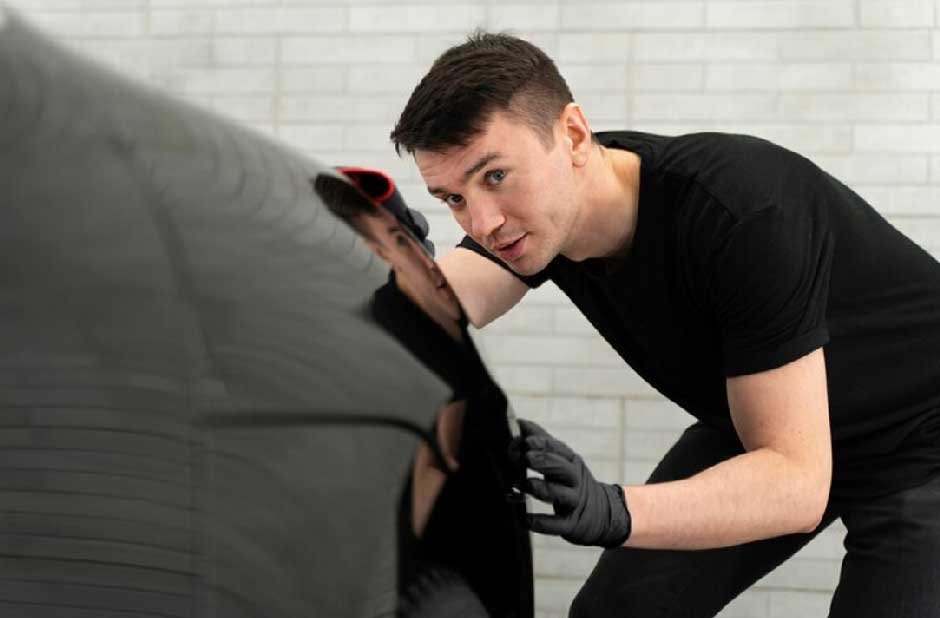If you own an aluminum car and you’ve just discovered that it’s been dented, the only thing on your mind right now is how to get it fixed.
Paintless dent repair (PDR) has emerged as a popular repair technique. But is it a suitable option for your aluminum vehicle? This article explores that and more. We’ll discuss the effectiveness of aluminum PDR, the factors that influence its success, and how to find the right PDR technician. We’ve got a lot to talk about, so let’s start with the basics.
The Rise of Aluminum in Car Manufacturing
Aluminum is significantly different from steel. However, it is being increasingly favored in car manufacturing due to its inherent qualities, such as:
- Since the metal is lightweight in nature, it improves fuel efficiency and reduces emissions.
- Aluminum panels are usually thinner, making the vehicle lighter.
- Aluminum is resistant to corrosion, so it doesn’t rust.
The Challenges of Aluminum
While the qualities of aluminum mentioned above offer great benefits to car manufacturers, they pose challenges, too. For instance:
- The thinness of aluminum increases the risk of stretching or tearing during repairs – if not handled carefully.
- While the metal doesn’t rust easily, it can corrode if handled improperly during repair.
- Aluminum is less malleable than steel, making it harder to manipulate during repairs.
- Aluminum has minimal elasticity and doesn’t “spring back” easily to its original shape.
These features make aluminum a unique material that requires specialized knowledge and tools to repair effectively.
Understanding Paintless Dent Repair
Paintless Dent Repair (PDR) is a non-invasive dent repair technique that removes minor dents and dings by manipulating the metal from behind the damaged area. It requires specialized tools and significant expertise to massage the metal back to its original shape without the need for fillers, sanding, or repainting.
Can Paintless Dent Repair Be Used on Aluminum Cars?
Yes, PDR can work on aluminum panels.
Advancements in PDR technology are continually improving the process for aluminum panels. High-strength adhesives and improved tools now enable technicians to tackle previously unrepairable dents. Furthermore, the growing prevalence of aluminum in vehicles has led to an increase in training programs specifically focused on aluminum PDR, enhancing the skills of repair professionals.
Advantages of PDR on Aluminum Cars
PDR offers distinct advantages to vehicles made of aluminum, such as:
Maintains Panel Integrity
Unlike traditional repairs, PDR leaves the panel intact. Since there is no need to cut, weld, fill, or repaint the damaged area, PDR helps maintain the car’s structural strength, and its original design remains unaltered.
Cost-Effective Repair Technique
PDR is usually cheaper than traditional dent repair or entire aluminum panel replacement if the damage is too severe.
No Paint Matching Issues
PDR does not require repainting, it avoids the challenges associated with paint matching, which can be especially tricky for aluminum panels that often have unique finishes.
The Limitations of PDR on Aluminum
I’ll be honest. PDR for steel is not the same as PDR for aluminum. Here’s why:
- Aluminum’s lack of elasticity often needs more force and finesse to remove a dent.
- PDR on aluminum cars requires specialized tools and skills. That means technicians require advanced training and extensive experience to properly repair dents.
- The size of a dent and its location matters. Small, shallow dents are more suitable for PDR. Additionally, large, deep dents that have caused extensive damage will require additional techniques. However, dents near structural reinforcements or the edge of a panel can become challenging to repair.
The success of PDR on aluminum panels depends on finding a skilled professional who understands the intricacies of working with this material.
Tips for Choosing a PDR Specialist for Aluminum Repairs
The PDR specialist you choose can make the difference between a flawless repair job and one that ruins your car’s finish. Needless to say, it’s a decision that requires careful consideration—especially if you own an aluminum car. The metal’s properties, such as its low elasticity and high rigidity, make it challenging to work with.
But searching for the right technician is easier than you think. The following tips can help you find a professional who knows how to restore your aluminum car’s appearance.
1. Look at the Level of Experience
Choose a technician with proven expertise in aluminum repair. Unlike steel, aluminum dents don’t easily pop back into shape as easily. However, an experienced technician will know how to handle the material and knows how to get the job done.
2. Verify Certifications and Training
Check the technician’s certifications. Credentials from a reputable PDR training institution ensure that the technician has the professional training required to repair aluminum.
3. Assess the Tools and Technology
In order to repair aluminum, technicians need specialized tools that are different from those used to repair steel. With the right equipment, technicians can address the repairs effectively.
4. Check Reviews and References
Read customer reviews or ask for references. Clients often discuss their experiences – whether good or bad. And the best part is you can easily find PDR specialists in your area. So, if you live in Texas or nearby, finding experts of paintless dent repair in Texas is a hassle-free endeavor. Contact them and get your beloved aluminum car fixed.
5. Look for Transparent Pricing
A technician who provides a detailed estimate and explains the costs is more likely to deliver transparent, reliable service. Quality repairs on aluminum may cost more, but the investment ensures professional results.
When Is PDR the Right Choice?
PDR is an excellent option for aluminum cars in specific scenarios:
- Small, Isolated Dents: Ideal for hail damage or parking lot dings.
- Undamaged Paintwork: If the paint remains intact, PDR can restore the panel seamlessly.
- Quick Repairs Needed: PDR is the fastest method for addressing minor dents.
However, if the dent is accompanied by paint damage, sharp creases or involves structural elements, traditional repair methods might be necessary.
Over to You
Paintless Dent Repair is a valuable option for repairing aluminum cars. While it may not be the best solution for every type of dent, PDR remains an effective method for preserving the appearance and value of aluminum vehicles when performed by a skilled professional. As the automotive industry continues to embrace aluminum for its many benefits, understanding the nuances of PDR on aluminum panels will help you make informed decisions and achieve the best possible repair outcomes.






